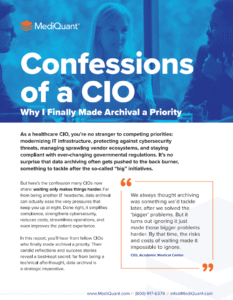Legacy Health Application Data: A Proven Method for Elevating the Patient Experience
By integrating legacy data into innovative systems and strategies, hospitals can not only improve patient outcomes, but also create more efficient, responsive and satisfying healthcare experiences.
During a recent Becker’s Healthcare digital event, “How Health Systems are Elevating the Patient Experience with Legacy Data,” Shelly Disser, Vice President, of Innovation and Collaboration at MediQuant, discussed the benefits of using historical data insights to improve the patient experience, sharing the keys to success.
Five key takeaways were:
1. Legacy data helps to create a 360-degree view of the patient. Historical patient record data can be used to create tailored and proactive treatment plans. “When you move from a legacy health IT system to a newer system, you don’t want to lose track of all the valuable data that was collected clinically or financially,” Dr. Disser said. “You want to see your patients’ holistic health state and how their health has changed over the years.”
2. Streamlined access to patient information enhances care coordination. By integrating legacy data with modern electronic health records (EHRs), healthcare organizations can ensure seamless transitions for patients as they move between providers and departments. “Integrating legacy system data with your EHR shows patients that you are listening to them and treating them from a personalized perspective,” Dr. Disser said.
3. Historical information can enhance patient engagement. For example, past communication data sheds light on patient preferences. Hospitals and health systems can use this to tailor communications like reminders, follow-ups and educational content. Making legacy and current application data visible to patients through a FHIR-compliant legacy application or archive can also improve the patient portal experience.
4. Data migration and security are keys to success when leveraging legacy information. When selecting an archive partner, look for a vendor with robust extract, transform and load (ETL) processes for migrating and cleansing data. In addition, it’s critical to find a vendor who adheres to stringent privacy and cybersecurity protocols and invests in certifications like FED RAMP and HITRUST. “Data security is a huge consideration around making legacy data accessible to support patient care,” Dr. Disser said.
5. Staff training is also essential for utilizing legacy data effectively. The most successful legacy data archive projects are the ones that engage staff who will be using information. “We involve physicians in our projects and so should you,” Dr. Disser said. “The last thing you want is a project where you’re integrating legacy data with your current EHR data and you don’t get feedback from clinicians about how it looks, how it flows or how they find their particular data.”
More Thought-Leadership
Confessions of a CIO: Why Data Archival is Key to IT Success
As a healthcare CIO, you’re juggling countless priorities—modernizing IT infrastructure, managing cybersecurity threats, and staying compliant with ever-changing regulations. It’s no wonder data archiving often gets pushed to the back burner. But here’s the truth:...
How to Avoid the #1 EHR Data Conversion Mistake (Hint: It’s Scope)
The riskiest part of your EHR data conversion isn’t the data. It’s the scope creep no one sees coming. Most healthcare organizations underestimate how many systems, data types, and workflows are tangled together. Even less have a grasp on the number of staff needed to...
Preserving the Past to Power the Future: Why Legacy Data Matters in Healthcare’s Next Chapter
If there is one constant in healthcare information technology, that’s the demand for change. Whether that change is driven by regulatory compliance, or efforts to improve patient outcomes, reduce costs, or promote efficiencies, new systems are constantly being...
Contact Us Today








